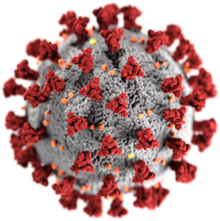Spike protein
Appearance

This article needs additional citations for verification. (November 2018) |
A peplomer is a glycoprotein spike on a viral capsid or viral envelope.[1] These protrusions will only bind to certain receptors on the host cell; they are essential for both host specificity and viral infectivity. The term "peplomer" is typically used to refer to a grouping of heterologous proteins on the virus surface that function together. [citation needed]
The tail fibers of some bacteriophages, especially the T4-like phages, are modified peplomers.
Influenza virus has two kinds of peplomers:
- triangular, spike-shaped "haemagglutinin"
- mushroom-shaped "neuraminidase". [citation needed]
See also
References
- ^ Saunders Comprehensive Veterinary Dictionary (3rd ed.). Elsevier, Inc. 2007. as cited in "peplomer". The Free Dictionary. Farlex. 2011. Retrieved 30 Mar 2011.
